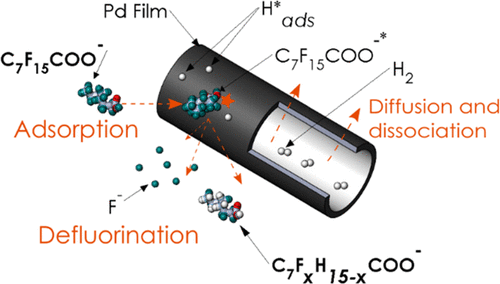当前位置:
X-MOL 学术
›
Environ. Sci. Technol.
›
论文详情
Our official English website, www.x-mol.net, welcomes your
feedback! (Note: you will need to create a separate account there.)
Adsorption and Reductive Defluorination of Perfluorooctanoic Acid over Palladium Nanoparticles
Environmental Science & Technology ( IF 10.8 ) Pub Date : 2021-09-09 , DOI: 10.1021/acs.est.1c03134 Min Long 1, 2 , Juan Donoso 2, 3 , Manav Bhati 2, 3 , Welman C Elias 3 , Kimberly N Heck 2, 3 , Yi-Hao Luo 1 , YenJung Sean Lai 1 , Haiwei Gu 4 , Thomas P Senftle 2, 3 , Chen Zhou 1, 2 , Michael S Wong 2, 3 , Bruce E Rittmann 1, 2
Environmental Science & Technology ( IF 10.8 ) Pub Date : 2021-09-09 , DOI: 10.1021/acs.est.1c03134 Min Long 1, 2 , Juan Donoso 2, 3 , Manav Bhati 2, 3 , Welman C Elias 3 , Kimberly N Heck 2, 3 , Yi-Hao Luo 1 , YenJung Sean Lai 1 , Haiwei Gu 4 , Thomas P Senftle 2, 3 , Chen Zhou 1, 2 , Michael S Wong 2, 3 , Bruce E Rittmann 1, 2
Affiliation

|
Per- and polyfluoroalkyl substances (PFASs) comprise a group of widespread and recalcitrant contaminants that are attracting increasing concern due to their persistence and adverse health effects. This study evaluated removal of one of the most prevalent PFAS, perfluorooctanoic acid (PFOA), in H2-based membrane catalyst-film reactors (H2-MCfRs) coated with palladium nanoparticles (Pd0NPs). Batch tests documented that Pd0NPs catalyzed hydrodefluorination of PFOA to partially fluorinated and nonfluorinated octanoic acids; the first-order rate constant for PFOA removal was 0.030 h–1, and a maximum defluorination rate was 16 μM/h in our bench-scale MCfR. Continuous-flow tests achieved stable long-term depletion of PFOA to below the EPA health advisory level (70 ng/L) for up to 70 days without catalyst loss or deactivation. Two distinct mechanisms for Pd0-based PFOA removal were identified based on insights from experimental results and density functional theory (DFT) calculations: (1) nonreactive chemisorption of PFOA in a perpendicular orientation on empty metallic surface sites and (2) reactive defluorination promoted by physiosorption of PFOA in a parallel orientation above surface sites populated with activated hydrogen atoms (Hads*). Pd0-based catalytic reduction chemistry and continuous-flow treatment may be broadly applicable to the ambient-temperature destruction of other PFAS compounds.
中文翻译:

全氟辛酸在钯纳米颗粒上的吸附和还原脱氟
全氟和多氟烷基物质 (PFAS) 是一组广泛存在且顽固的污染物,由于其持久性和不利健康影响而引起越来越多的关注。该研究评估了在涂有钯纳米粒子 (Pd 0 NPs) 的H 2膜催化剂膜反应器 (H 2 -MCfRs) 中去除最普遍的 PFAS 之一、全氟辛酸 (PFOA ) 的情况。批量测试表明,Pd 0 NPs 催化全氟辛酸加氢脱氟为部分氟化和非氟化的辛酸;PFOA 去除的一级速率常数为 0.030 h –1,在我们的实验室规模 MCfR 中,最大脱氟速率为 16 μM/h。连续流动测试实现了 PFOA 的长期稳定消耗,低于 EPA 健康建议水平 (70 ng/L),持续时间长达 70 天,而没有催化剂损失或失活。基于实验结果和密度泛函理论 (DFT) 计算的见解,确定了两种不同的基于Pd 0的 PFOA 去除机制:(1) PFOA 在空金属表面垂直方向上的非反应性化学吸附和 (2) 促进了反应性脱氟通过在填充有活性氢原子的表面位点上方平行方向对全氟辛酸进行物理吸附(H ads *)。钯0基于催化还原化学和连续流处理可广泛适用于其他 PFAS 化合物的环境温度破坏。
更新日期:2021-11-02
中文翻译:

全氟辛酸在钯纳米颗粒上的吸附和还原脱氟
全氟和多氟烷基物质 (PFAS) 是一组广泛存在且顽固的污染物,由于其持久性和不利健康影响而引起越来越多的关注。该研究评估了在涂有钯纳米粒子 (Pd 0 NPs) 的H 2膜催化剂膜反应器 (H 2 -MCfRs) 中去除最普遍的 PFAS 之一、全氟辛酸 (PFOA ) 的情况。批量测试表明,Pd 0 NPs 催化全氟辛酸加氢脱氟为部分氟化和非氟化的辛酸;PFOA 去除的一级速率常数为 0.030 h –1,在我们的实验室规模 MCfR 中,最大脱氟速率为 16 μM/h。连续流动测试实现了 PFOA 的长期稳定消耗,低于 EPA 健康建议水平 (70 ng/L),持续时间长达 70 天,而没有催化剂损失或失活。基于实验结果和密度泛函理论 (DFT) 计算的见解,确定了两种不同的基于Pd 0的 PFOA 去除机制:(1) PFOA 在空金属表面垂直方向上的非反应性化学吸附和 (2) 促进了反应性脱氟通过在填充有活性氢原子的表面位点上方平行方向对全氟辛酸进行物理吸附(H ads *)。钯0基于催化还原化学和连续流处理可广泛适用于其他 PFAS 化合物的环境温度破坏。











































 京公网安备 11010802027423号
京公网安备 11010802027423号